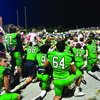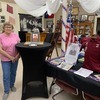Where in the world: The rise and fall of Braniff Airways
Braniff Airways started flying in the 1930s with a small fleet of DC2s and DC3s. They soon merged with Mid-Continent and Panagra, an airline based in Panama.
I flew as a ‘hostess’ for Braniff in 1960-61, first for one month out of Kansas City, then the remainder of time out of Dallas Love Field. Our training was at the Braniff Building at Love Field, shared space with a hangar, offices and classrooms.
Braniff had grown and was a well-respected domestic and international airline with routes in North and South America. A radical makeover in 1967 caught the attention of the industry and the flying public. It was noted as ‘The End of the Plain Plane.’ Braniff replaced the old red, white and blue paint on planes with multiple bright colors that set them apart from all others on the runway. They were known as the Flying Colors of Braniff.
Later, there were planes, as well as posters and prints, painted in swirls of color by Alexander Calder designs. Then, they had uniforms designed in bright colors with multiple mix and match parts by Emilio Pucci. They carried the designs over to their gates, a new building at DFW, offices, advertisements and earned a reputation as the most flamboyant airline on ground or in the air.
A theme for their advertisements was ‘if you’ve got it, flaunt it!’ My particular favorite ad was the little old lady hiding silverware in her purse, walking off the plane with a blanket and pillow, then driving a tow tractor across the tarmac, pulling the plane behind her, saying ‘if you’ve got it, flaunt it!’
With deregulation, a fierce battle of DFW heated up between Braniff and American Airlines. Braniff expanded routes to Europe and then to Asia with a fleet if Boeing 747s. Money did not seem to be an object. Their designer planes, designer uniforms by Pucci and later by Halston, and elegant service were “over the top.”
As a result of deregulation, over-expansion and over-spending, Braniff lost the Battle of DFW and declared bankruptcy, ceasing operations on May 12, 1982. It was a shock to all, especially passengers and employees who were left stranded, some in foreign countries.
They found a gate but there was no ground crew to send out the jetway. The flight attendants finally exited the plane through a stairway in the tail of the plane and went into the terminal and found one person to bring out a set of stairs for passengers to deplane.
The terminal was deserted. I supposed the pilots and flight attendants had to unload the luggage. Employees lost their retirement, jobs and security. It was a tragic end to a wonderful airline and careers for many. Conspiracy theories still float about who did what to kill Braniff. We’ll never know for sure all the under-the-table deals that went with it!
Alas, Braniff has not been forgotten. The organization for former Flight Attendants, ‘Clipped B’s,’ is still active. The Museum of Flight at Dallas Love Field has a very nice display of Braniff memorabilia, which is quite collectible now. The gift shop also sells Braniff-themed items. The old Braniff building at Love Field, which has been empty for years, is being re-designed to house offices, a hangar, businesses, etc.
There is even a display of Braniff uniforms at Tyler Pounds Aviation Museum in the old terminal. The Braniff Airways Foundation was formed to preserve the history and artifacts of Braniff. It is an active organization and has placed plaques at significant places around the world in memory of Braniff International Airways. They are hosting the third History and Architecture Conference this year in September.
You can Google Braniff Airways Foundation if you would like to read more about it. Braniff will never be forgotten by those who were privileged to be a part of that history!
Please support The Cherokeean Herald by subscribing today!
